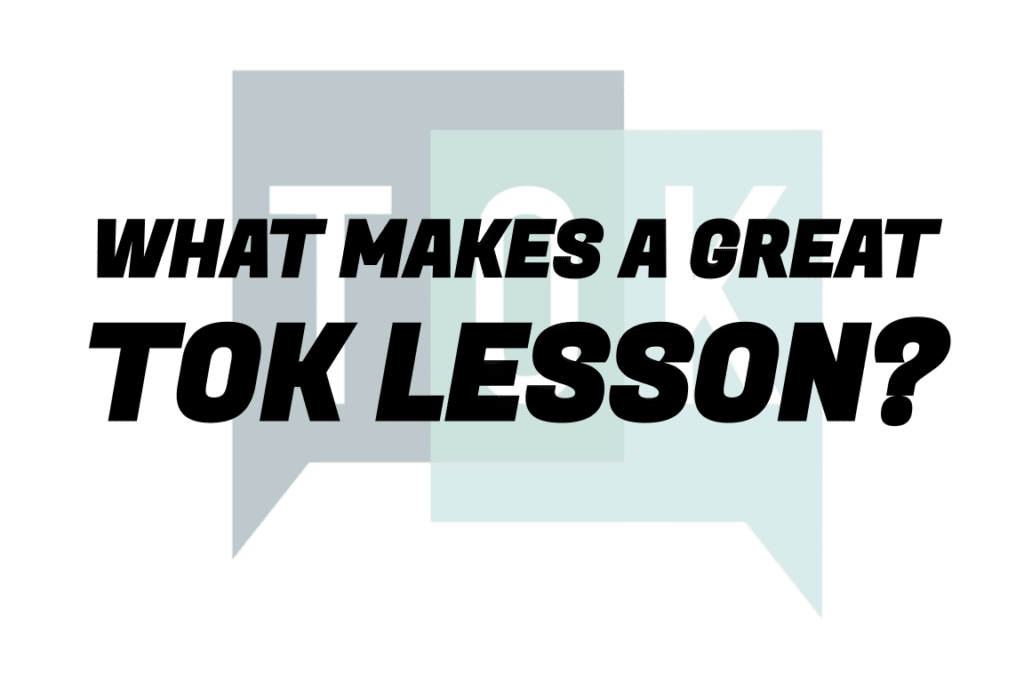
What makes a great TOK lesson? What learning objectives should you be setting – and how do you test for understanding? How do you make sure what you are teaching links to the course structure? How do you keep the students engaged? How much should you be referring to the two assessment tasks in individual lessons? Here we try to answer these, and other questions, to ensure you’re offering your students the best possible learning experience.
Designing a clear scheme of work
Designing a clear scheme of work is the first step in ensuring that you’ll be able to track students’ learning, and help them develop as thinkers. Rather than basing units on the different themes and areas of knowledge, it will help if you base your units on questions, which will mean students can evaluate their own understanding as they progress, and take ownership of important concepts that will set them up for the essay and exhibition. Question-based units will also make it easier to sharpen the LOs of individual lessons, and ensure that everything your students do will be driven by a clear purpose.
Your scheme of work should be easily accessible by your students, so they can see both where they are going, and what they have completed. Members of the site have access to unit overviews for all six of the Big Questions (on the BQ management page of the site), which provide students with the name of each lesson, its learning objective, and a brief summary of the ideas and thinkers covered. As we discuss below, making good use of technology, such as Google Classroom or ManageBac, will also help to make your course visible.
Measurable and well aligned learning objectives
Each lesson should have a clear and measurable learning objective, which aligns to the tasks you set your students. We recommend wording your exit task very similarly to the learning objective, so what your students submit, and what you check, is as close as possible to what you are hoping to achieve with your students.
Students don’t need to submit anything more than their response to the exit task – everything else should be saved within their TOK folder (which can be either electronic, paper, or a combination). Get them used to justifying their responses to the exit questions by referring to as many points from the lesson as possible. This is what you’ll using to assess whether they have ‘got’ the main concept of the lesson, and what you will base your feedback comment on.
You can see how this works in practice by looking at our sample lesson presentations. Look at the lesson objective of a lesson, see how it relates the Big Question, aligns to the lesson activities, and how the exit task asks students to offer a direct response to the learning objective. Combined with the assessment tracker (discussed below), this means that you’ll have an incredibly effective tool for monitoring students’ progress during every step of the course, and act as a scaffold for their learning.
Using technology to support the delivery of TOK
By ‘technology’, we’re not thinking too ambitiously – just the use of Google Slides, or PowerPoint presentations that students can consult to check after the lesson has ended (or when they are creating their exhibitions and essay), and a means of providing feedback to students. Google Classroom is a fantastically useful tool, which by the end of the course acts as a kind of online textbook, and through which you can provide your students with feedback. This is obviously particularly helpful if your students are learning online (see our webinar for more tips on teaching TOK online).
We’ve also created a set of Google Sheets assessment trackers for members of the site, which we discuss in detail below. The comments that we’ve provided for each of the 72 BQ lessons can be easily edited, and added to Google Classroom, and provide both encouragement and guidance to students as they journey through the TOK course.
Our purpose-built assessment trackers

Members of the site have access to our assessment tracker documents, which provide three different levels of feedback comments for each of the 72 BQ lessons, and enable you to monitor your students’ learning and development during the course. We’ve based the feedback comments on the language found in the assessment instrument. Download the assessment tracker for BQ4 here to see how this looks in practice.
Select a comment that matches the exit response submitted by individual students, copy-paste it into the right place on the tracker (editing it if necessary), and then paste it again into Google Classroom. You’ll be able to create a set of meaningful feedback comments for an entire class quickly and efficiently, and help your students to develop their understanding. When it comes time to writing end of term reports, you’ll have instant access to all your comments, and have a visual overview via the colour-coding of the feedback.
If you have any questions about how to use the assessment trackers, don’t hesitate to get in touch with us via the contact form below.

Become a member of theoryofknowledge.net
Members have access to a huge range of classroom-ready TOK resources, including three different TOK Courses, the monthly TOK Mini-Lessons, our TOK Padlets, the Integration Tool, TOK Filmography, and loads more engaging, innovative resources!
Join in seconds here, and turn your school into a hub of authentic critical thinking.